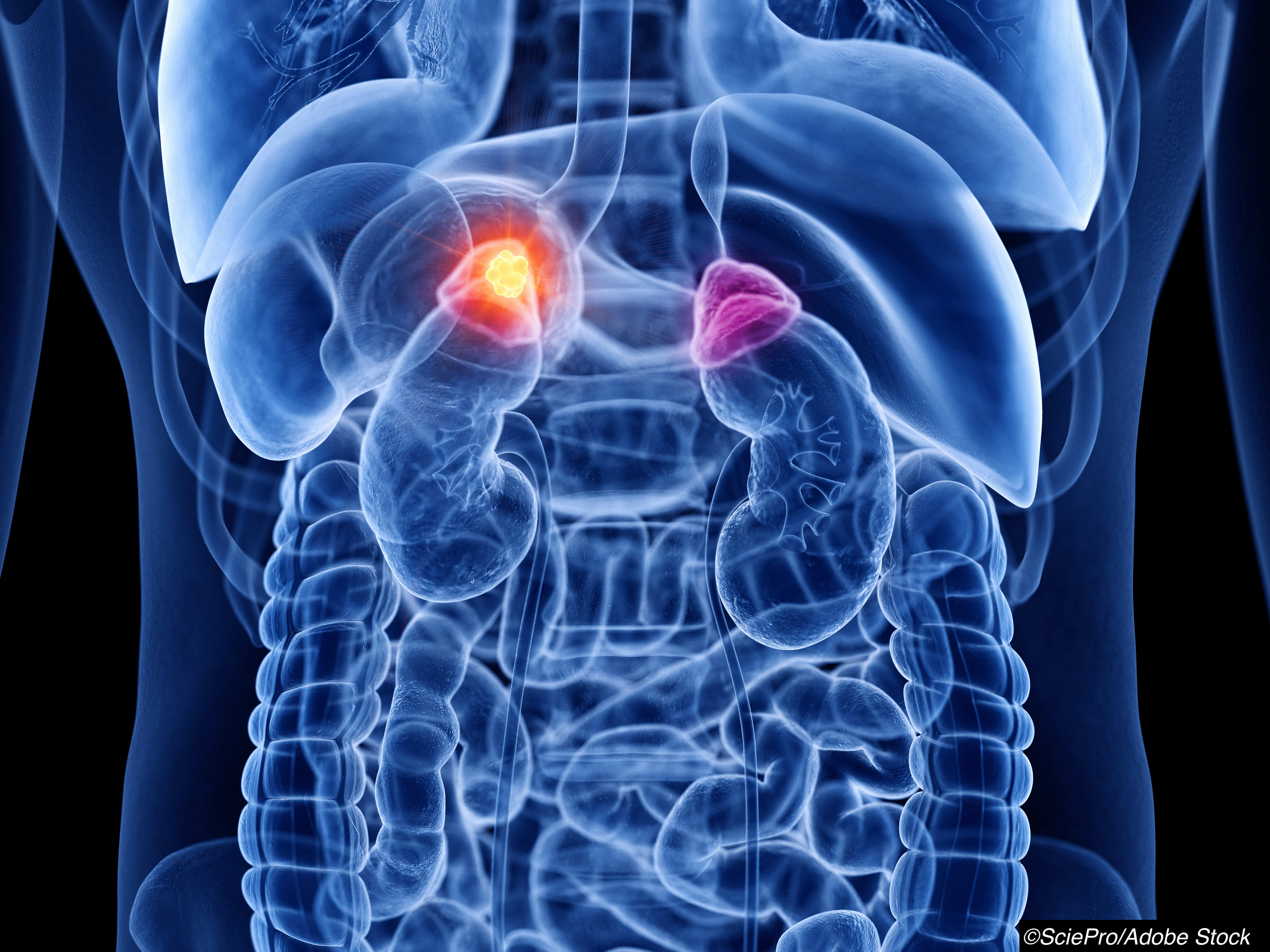
Patients with mild autonomous cortisol secretion (MACS)—particularly older women—are at significantly increased risk for uncontrolled hypertension and type 2 diabetes, according to results from the European Network for the Study of Adrenal Tumors (ENSAT) Evaluation of Urine Steroid Metabolomics in the Differential Diagnosis of Adrenocortical Tumors (EURINE-ACT) study, which are published in Annals of Internal Medicine.
Researchers also found that MACS is significantly more common than previously believed, affecting nearly half of patients in the study, most of whom were women (70%) and over 50 years old.
“Compared to those without MACS, we observed that patients with MACS were more likely to be diagnosed with high blood pressure and to require three or more tablets to achieve an adequate blood pressure control. When we looked at patients with a diagnosis of type 2 diabetes, those with MACS were twice more likely to be treated with insulin, indicating that other medications haven’t helped managing their blood sugar levels,” noted first author of the study, Allessandro Prete, MD, of the University of Birmingham’s Institute of Metabolism and Systems Research, in a press release. “In conclusion, our study found that MACS is very frequent and is an important risk condition for high blood pressure and type 2 diabetes, especially in older women, and the impact of MACS on high blood pressure and type 2 diabetes risk has been underestimated until now.”
Adrenal incidentalomas—or benign adrenal tumors—can occur in up to 10% of adults, and they can be nonfunctioning adrenal tumors (NFATs) or can autonomously oversecrete hormones such as cortisol, Prete and colleagues explained.
“Mild autonomous cortisol secretion (MACS), previously also termed subclinical [Cushing syndrome] CS, is regularly diagnosed in persons with benign adrenal tumors and is defined by failure to suppress serum cortisol sufficiently after overnight administration of 1 mg of dexamethasone in the absence of the typical clinical signs of cortisol excess. Previous case series identified MACS in up to 35% of persons with benign adrenal tumors, making it the most common hormonal abnormality observed in this population,” they wrote. “However, although CS is a well-established cause of increased cardiometabolic morbidity and mortality, evidence about the effect of MACS on cardiometabolic disease risk is scarce and heterogeneous.”
In the cross-sectional ENSAT EURINE-ACT study—the largest on adrenal incidentalomas to date—Prete and colleagues assessed the burden of cardiometabolic disease and steroid secretion in 1,305 patients (median age at diagnosis: 60 years; 67.3% women) with benign adrenal tumors with and without MACS from 14 endocrine secondary and tertiary care centers.
They defined cortisol excess via clinical assessment and 1-mg overnight dexamethasone-suppression testing, with serum cortisol levels ˂50 nmol/L denoting nonfunctioning adrenal tumor (NFAT); levels of 50 to 138 nmol/L, possible MACS (MACS-1); and levels >138 nmol/L and absence of typical clinical Cushing syndrome features as definitive MACS (MACS-2). Patients’ net steroid production was measured using multisteroid profiling of 24-hour urine via tandem mass spectrometry.
In all, 49.7% of patients had NFAT (n=649; 64.1% women), 34.6% had MACS-1 (n=451; 67.2% women), 10.7% had MACS-2 (n=140; 73.6% women), and 5.0% had Cushing syndrome (n=65; 86.2% women).
Patients with MACS-2 and Cushing syndrome had a higher prevalence and severity of hypertension compared with NFAT, with the following adjusted prevalence ratios [aPRs]:
- MACS-2: 1.15 (95% CI: 1.04-1.27).
- Cushing syndrome: 1.37 (95% CI: 1.16-1.62).
Corresponding aPRS for the use of three or more antihypertensive medications were 1.31 (95% CI: 1.02-1.68) and 2.22 (95% CI: 1.62-3.05), respectively.
Patients with Cushing syndrome also had a higher prevalence of type 2 diabetes compared with NFAT (aPR: 1.62; 95% CI: 1.08-2.42) and were also more likely to need insulin therapy for MACS-2 (aPR: 1.89; 95% CI: 1.01-3.52) and Cushing syndrome (aPR: 3.06; 95% CI: 1.60-5.85).
Upon analysis of urinary multisteroid excretion profiles, researchers found that patients with MACS-1, MACS-2, and Cushing syndrome had gradual decreases in 24-hour excretion of androsterone, etiocholanolone, dehydroepiandrosterone, and pregnenetriol, compared with patients with NFAT. These patients also exhibited a progressive increase in 24-hour cortisol and tetrahydro-11-deoxycostisol excretion. Patients with MACS-2 and Cushing syndrome had increased cortisone excretion.
“Previous studies suggested that MACS is associated with poor health. However, our study is the largest ever study to establish conclusively the extent of the risk and severity of high blood pressure and type 2 diabetes in patients with MACS. Our hope is that this research will put a spotlight on this condition and increase awareness of its impact on health. We advocate that all patients who are found to carry an adrenal incidentaloma are tested for MACS and have their blood pressure and glucose levels measured regularly,” concluded senior author Weibke Arit, MD, DSc, Director, University of Birmingham’s Institute of Metabolism and System Research, in a press release.
In his accompanying editorial, André Lacroix, MD, of the Centre Hospitalier de l’Université de Montréal, Québec, Canada, wrote: “What lessons are offered by this study, the largest to date on adrenal incidentalomas? These data clearly support the [European Society of Endocrinology] ESE guideline recommendations that clinicians should determine precisely the cardiometabolic consequences of mild cortisol secretion in patients with adrenal lesions, whether unilateral or bilateral.”
Study limitations include its cross-sectional design, exclusion of longitudinal cardiometabolic outcomes data, the absence of a comparator group without adrenal tumors, and the non-standardization of routine biochemical tests.
-
Mild autonomous cortisol secretion (MACS) is a cardiometabolic risk condition that predominantly affects women and warrants regular assessment for hypertension and type 2 diabetes.
-
Affected patients should undergo cardiovascular risk assessment at the time of diagnosis, with particular attention paid to blood pressure and glucose metabolism.
Liz Meszaros, Deputy Managing Editor, BreakingMED™
The ENSAT EURINE-ACT study was funded by Diabetes UK, the European Commission, U.K. Medical Research Council, the U.K. Academy of Medical Sciences, the Wellcome Trust, the U.K. National Institute for Health Research, the U.S. National Institutes of Health, the Claire Khan Trust Fund at University Hospitals Birmingham Charities, and the Mayo Clinic Foundation for Medical Education and Research.
Prete reported no disclosures.
Arit has received grants from the European Commission, Medical Research Council, and University Hospitals Birmingham Charities, and support from the National Institute for Health Research, U.K.
Lacroix reported no disclosures.
Cat ID: 12
Topic ID: 76,12,730,6,12,187,192,918,925


